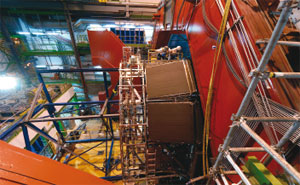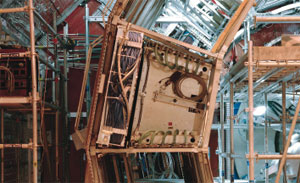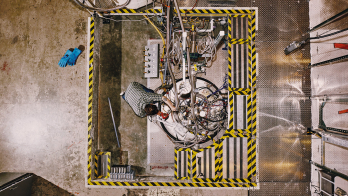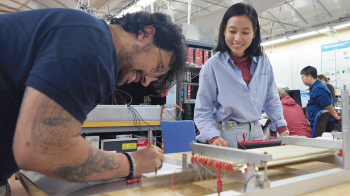When it starts up the ALICE experiment will observe collisions of heavy ions in CERN’s Large Hadron Collider (LHC), where “fireballs” of extremely hot and dense matter will be fleetingly made. Up to 20,000 tracks will emerge from each fireball, and one of the challenges for ALICE will be to identify different particles among this veritable “haystack” (in p20). Different elements in the armoury of particle identification for ALICE are now arriving in the experiment’s underground cavern, beginning with the High Momentum Particle Identification Detector (HMPID), which was installed inside the solenoid magnet on 23 September. This was soon followed by the first elements of the Time of Flight (TOF) system and the Transition Radiation Detector (TRD).

The HMPID will extend hadron identification in ALICE up to 5 GeV/c, complementing the reach of the other particle-identification systems. It is a ring-imaging Cherenkov detector in a proximity-focusing configuration, which uses liquid C6F14 as the radiator medium, while a 300 nm layer of caesium iodide (CsI) on the cathode of a multiwire proportional chamber converts the Cherenkov photons into electrons. This layer is divided into 161,280 pads, each 8 mm square, which are individually read out by two ASIC chips, GASSIPLEX and DILOGIC, developed with the Microelectronics Group at CERN.
The complete HMPID, realized by Bari University and INFN, CERN (PH-DT1, -DT2 and -AIT groups) and the Institute for Nuclear Research, Moscow, is approximately 8 m wide by 8 m tall, and weighs about 5 t. It comprises seven identical modules shaped to fit against two sides of ALICE’s octagonal magnet. The modules, fully equipped with electronics, were individually transported to ALICE and mounted on a support structure. The complete HMPID was then lowered into the cavern and inserted inside the magnet. Three months of preparation by CERN (PH-DT1 and AIT) and Bari groups, and the help of the CERN transport service, ensured that transport and installation were accomplished within a few hours.

With an active area of about 11 m2 covered with CsI, the HMPID is the largest application of this technology. Development began at CERN in the RD26 project, and it took 15 years for the method to reach the current scale and efficiency. The full production of the 42 photocathodes required to equip the detector, from CsI deposition to quality control, was done by the groups at CERN.
The first week of October saw the installation of the first two supermodules for the TOF system, which will be used to identify the thousands of pions, kaons and protons produced in each fireball. Its basic element is a multigap-resistive-plate-chamber (MRPC) strip, with a 120 cm × 7.4 cm active area made of a sandwich of resistive glass sheets (0.4 mm thick) and spacers, with 96 readout pads, each 3.5 cm × 2.5 cm. The full detector, which contains 1638 MRPC strips with a total of 157,248 readout channels, covers a cylindrical surface of about 150 m2 at 3.7 m from the beamline, and weighs 25 t. It is the responsibility of the INFN sections in Bologna and Salerno, in collaboration with the Institute for Theoretical and Experimental Physics, Moscow, and Kangnung National University, Republic of Korea.
The TRD must identify high-energy electron pairs generated in the fireballs. It comprises 18 supermodules that form a cylinder around the large Time Projection Chamber in the central barrel of the ALICE experiment. Each supermodule is about 7 m long and comprises 30 drift chambers in six layers. The construction of the modules is a collaboration between the Universities of Frankfurt and Heidelberg, GSI Darmstadt, the National Institute of Physics and Nuclear Engineering, Bucharest, and the Joint Institute for Nuclear Research, Dubna, with the radiators produced at the University of Munster.
During the summer the drift chambers for the first supermodule were equipped with readout electronics and inserted into the supermodule hull at the University of Heidelberg. After transportation to CERN on 27 September, the module was tested on the surface using cosmic rays before being lowered into the ALICE cavern on 9 October. The final installation took place a day later.








